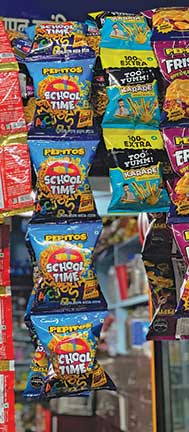Anuradha C
If you visit school canteens in affluent urban neighbourhoods, chances are that you will come across junk food stacked up for sale. Chips, noodles, ice-creams and a lot else is up for grabs. And schools, including reputed ones, often put-up images of canteens with junk food on their websites!

In corporate foodcourts, cooked food is available. Simply because the employee may not have the time to cook and pack food from home. However, in schools, it is assumed that the children would carry nutritious food from home, for lunch and snack breaks. It’s supposed to be mummy’s solemn duty. At least that’s how it’s been for decades. So, school canteens were only meant for a quick nibble on rare occasions or a birthday treat to classmates.
However, we are living in an era where women are increasingly going out to work and are often away from home for 10-12 hours in a day. So, increasingly more and more school children are given pocket money instead of a lunch-box to avail canteen services. The daddies do pitch in with kitchen chores nowadays, but not enough to be entirely ‘food sufficient’. In this scenario, school canteens that primarily serve junk food, especially packed FMCG goods, become a major area of concern.
Serious nutritional deficiencies
The mid-day meal is critical for growing children. That is the reason why government schools prioritize the mid-day meal scheme as a critical factor in ensuring high school enrollments. NGOs entrusted with serving food through these schemes serve healthy, fresh, nutritious food appropriate to the climate and local conditions. I was involved with the Akshaya Patra scheme run by Iskcon and Adamya Chetana, an NGO in Bangalore. They do a fantastic job. You can see the glee and contentment on the children’s faces after partaking of a good meal.
However, in private schools, there is no centralized food delivery mechanism. Simply because the parents are supposed to be well-equipped to handle their children’s food needs. In the absence of children carrying food from home, school canteens in private schools need to shoulder this responsibility. If children are left to their own devices, chances are high that they will end up filling their bellies with junk food. This will cause serious growth deficiencies and hamper their learning abilities too.
Conflicted messaging
Another important aspect is in the messaging. Parents and teachers always preach about eating healthy and staying fit to children. Have your greens, eat a lot of fruits, don’t neglect your veggies, and what not.
But when we sell food to children – whether it is in malls, advertisements on TV, or school canteens, we only market junk food to them. Biscuits, chocolates, fried goodies, pastries, ice cream and so on. Marketing gurus focus on children as customers, ‘catch them young’ being the motto. Packaging is attractive, celebrities are roped in for endorsement – no efforts are left unturned.
How can we expect to get the ‘Eat healthy’ message across to children then? It’s a classic case of conflict between what we practice and what we preach.

Schools must take the lead
How to feed children healthy food which they actually enjoy. This problem requires a serious rethink and collective action. Schools must come forward to take the first step. Devising nutritious lunch menus which children can consume without adult supervision takes some careful planning and preparation. Fresh hot food must be given precedence over ready-to-eat food.
Just like schools plan for and provide transport services they can provide canteen facilities too. For this schools would need to invest in food preparation and serving arrangements. While this may not be very simple, it surely is doable.
Did you know?
The Food Safety and Standards Authority of India (FSSAI), in 2020, restricted the sale of junk and unhealthy food in school canteens and other educational institutions. Besides this, FSSAI, the country’s top food regulator, has prohibited the sale and advertisement of unhealthy food within 50 metres of school premises.
The author is an IT industry drop-out after several years of slogging and money-making. She is now working freelance as a corporate technical trainer and content writer. She is hoping to channelize her passion for writing into a satisfying experience for herself and a joyous experience for her readers. She can be reached at anuradhac@gmail.com.
